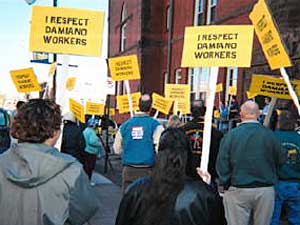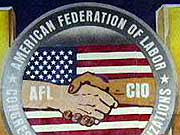|
Audio
Photos
Resources
Respond to this story
|
Trying different ways to organize
January 27, 2004
 |
| Workers at the Damiano Center in Duluth held a rally to show community support for their unionizing effort. (Photo courtesy UFCW Local 1116) |
Duluth, Minn. — The Damiano Center is a social service agency set up to help some of Duluth's poorest people. It occupies an old Catholic school downtown.
Most weekdays, more than 200 people come to the old school cafeteria for a hot meal. Some of the kitchen workers are training to become cooks.
Down the hall at the clothing exchange, people can pick up donated coats and boots. In the summer, there's a program for kids in the neighborhood.
 | |||
The center has a staff of 16 people who raise the money and run the programs. Last summer they decided they wanted to form a union.
Jeff Hilgert started as a volunteer. Now he writes the grants that pay for the services offered at the center.
"There was an at-will employment doctrine, which stated people could be terminated at any time for any reason," says Hilgert.
He says he and most of his co-workers felt insecure.
"There wasn't an atmosphere of feeling like people could honestly share their opinions and feelings about how things operated," he says.
Jeff Hilgert and his colleagues talked about what they could do. Fifteen of the 16 workers wanted to organize.
 | |||
They talked with union officials and heard horror stories about what usually happens. Most businesses fight workers who want to unionize. The employer might have big meetings and tell the workers what a bad idea the union is. They might say it will drive up costs and force the company to close. Sometimes they even meet one-on-one with workers and pressure them to vote against the union.
At the Damiano Center, Jeff Hilgert and his colleagues wanted to avoid all that. So they simply wrote a letter to the board of directors of the Damiano Center. They asked the board to recognize their union, and to sit down and negotiate a contract.
Laurie Johnson, an organizer with the United Food and Commercial Workers, helped the Damiano Center workers organize.
"We were told, as the outcome of one of the board meetings, that they would recognize the group," Johnson says. "Unfortunately a follow-up letter came saying, 'We will not recognize you, and we have now hired an attorney.'"
The attorney said the Damiano Center wouldn't accept the approach the workers were proposing. He said the center wanted to follow the more traditional path. which involves bringing in a federal agency, the National Labor Relations Board. The NLRB would determine which workers were eligible to join a union, and the agency would hold a formal vote.
 | |||
Johnson says that's when the activists kicked their organizing up a notch.
"Certainly we approached the board members themselves," Johnson says. "We approached people in the clergy and the community. We approached fellow union members in the community."
The workers and the union asked each group to get behind the organizing effort. Jeff Hilgert says they reached out for support in a variety of ways.
"We set up a Web site, we set up a hotline, we distributed over 4,000 flyers to the community," he says. "We had a rally in front of the building."
Hilgert says it was all done to show the board of the Damiano Center that the workers had community support.
|
What's behind this is an attempt to return to a more level playing field, and really, a more democratic system.
- Erik Peterson, labor relations professor |
But the center's executive director, Jean Gornick, didn't see it that way. She says the pressure amounted to harassment.
"I'm a member of the Episcopal Church, and e-mails and letters went out nationwide to the Episcopal Church asking them to comment on my behavior," says Gornick. "In fact, the bishop of Minnesota approached me saying that he had gotten a letter, and he was very offended by the letter."
Looking back, Gornick says she thinks both sides made mistakes. She says the union's campaign got too personal. But she also realizes she shouldn't have hired an attorney who would alienate the workers.
A week after the union began its community campaign, the Damiano Center board decided to get a new attorney. And the board voted to recognize the union without a government-run election.
Unions around the country are finding they're more successful when they bypass the National Labor Relations Board.
Adrienne Eaton researches labor issues at Rutgers University. She says when the federal agency comes in and conducts an election, unions win less than half the time. But when unions go directly to the employer and ask for recognition, they win 80 percent of the time.
 | |||
Eaton says approaching employers directly tends to minimize the employer's campaign against the union.
"It doesn't get rid of it all together," Eaton says. "But it substantially reduces both illegal forms of campaigning like firing people, as well as legal forms, like supervisor one-on-one meetings and those kinds of things."
Eaton says businesses voluntarily enter into these agreements with workers. She says there are various reasons why a company would agree to keep quiet while a union organizes its employees.
For instance, a business in financial trouble might ask its unionized workers to help it restructure. Or a company might ask the union to support it when it needs government approval to buy another firm. Unions can use this leverage to get the employer to agree not to fight the union when it organizes workers in another part of the company.
Minneapolis requires any hotel that gets financial help from the city to agree not to fight unionizing. Most recently, the Hotel Le Meridien in the city's Block E development agreed to be a union shop.
Erik Peterson, a labor historian at the University of Minnesota Duluth, says unions are learning they can be more successful when they bypass the government agency.
"It is by far the dominant way that workers are joining unions right now," Peterson says. "Ultimately, what's behind this is an attempt to really return to a more level playing field, and really, a more democratic system."
Unions have used alternative approaches, sometimes called labor peace agreements, to organize most of the hotel workers in Las Vegas. Nationwide, 17,000 telecommunications workers have been signed up this way. And in the last five years, 40,000 janitors around the country have joined unions through community campaigns.
|
News Headlines
|
Related Subjects
|

